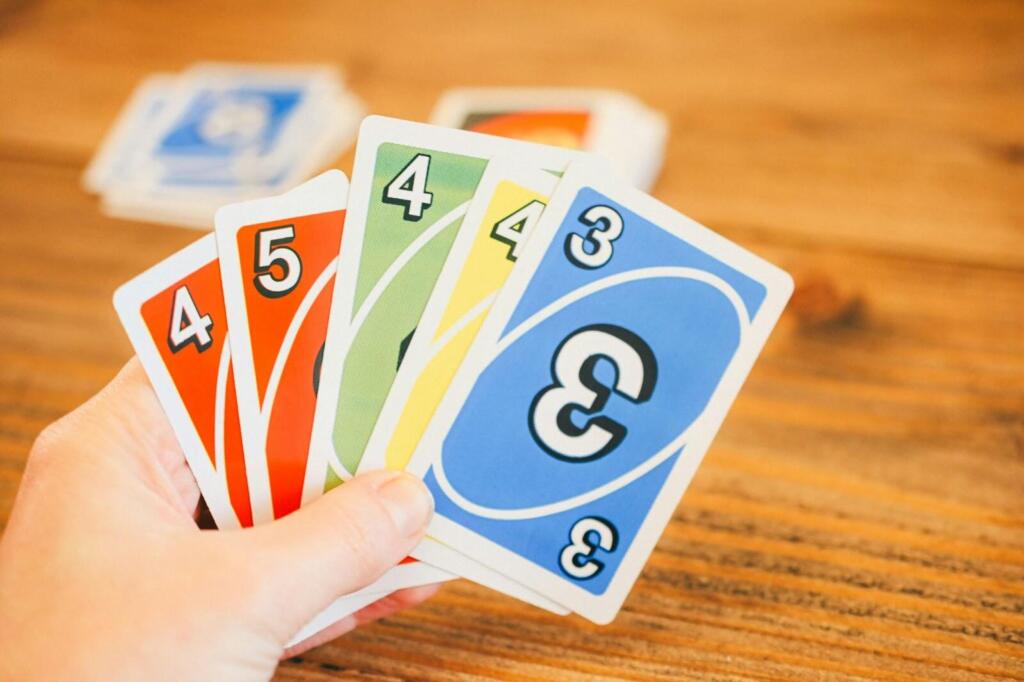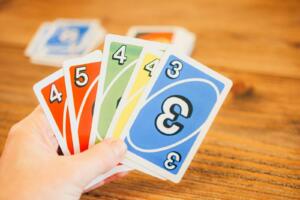Table of Contents

Many card games are designed to be easy to learn and fun to replay. The DOS card game – a modern spin-off from UNO that Mattel released in 2018 – fits into this category. Like its predecessor, it relies on coloured numbered cards and special actions. While it shares familiar mechanics with UNO, DOS adds fresh twists that change the flow of play.
What Is the DOS Card Game?
DOS is a shedding-type card game where the main goal is to be the first player to get rid of all your cards. Instead of one central pile like UNO, DOS uses two discard piles, giving players more choices in matching numbers and colours. Players score points by being the first to empty their hand, with points based on the value of cards left in opponents’ hands. Unlike UNO, where shouting “UNO!” is key, in DOS, players can call out “DOS!” when they’re down to two cards.
DOS vs. UNO: Key Differences
At first glance, DOS and UNO look similar, but the differences quickly change the experience. UNO has a single discard pile and relies heavily on matching by colour or number, while DOS centers on two piles and rewards number matches more directly. Another major difference is that in DOS, if you match a card exactly by number, you can play another card and even score bonus actions. In DOS, players can also combine two cards from their hand to equal the number on a centre pile.
Components & Setup
The DOS Card Game deck consists of 108 cards, featuring four coloured suits (blue, green, red, yellow) numbered from 1 to 10, along with Wild and # cards that function in special ways. Each player starts with seven cards, and two cards are placed face-up in the centre to serve as the starting discard piles. The draw deck is placed nearby, and gameplay begins clockwise around the table.
Turn Order and Matching Rules
On a turn, a player must try to match at least one of their cards to one of the centre piles. You can match by number regardless of the colour, and if the numbers add up, you may also lay down a combination of two cards to equal the centre card. For example, if the centre card is an 8, you could place a 5 and a 3 together. After playing, you draw new cards if you didn’t play or if the centre piles need to be refilled to two. Play continues clockwise following these patterns.
Scoring and How to Win
To score, players tally points when they go out, with the winner receiving points based on the cards left in opponents’ hands. Numbered cards count by their face value, while Wild DOS cards hold a higher point value. The first player to reach a set score total, often 200, is declared the overall winner. For a shorter game, some groups prefer to play multiple rounds and count victories instead of points.
Wilds and Special Cards Explained
DOS features unique cards that add flexibility and strategy. The Wild DOS card can represent any number but requires players to declare which one it is when played. The “#” card works as a wild colour card, helping balance tricky situations when colour-matching bonuses are needed. Unlike UNO, special attack cards like “Draw Two” or “Skip” are absent.
2-Player and Team Variants
Playing the DOS Card Game with two people keeps the pace quick, but some of the back-and-forth strategy is less intense than in larger groups. Team play, on the other hand, is where DOS grows more tactical, allowing partners to plan combinations and assist each other in setting up matches. Team rules recommend sitting opposite your partner. From that moment on, coordination becomes key.
Beginner Strategies
For beginners, the main tip is to prioritise exact matches whenever possible, since these give you additional benefits like bonus plays or the chance to play multiple cards at once. Try to balance your colours and numbers in hand, making sure you’re not stuck later with only high-value cards that are harder to match. Keeping an eye on the centre piles and anticipating which numbers might come into play also helps.
Advanced Tactics & Table Talk
More experienced players often plan two to three turns ahead, deliberately holding onto certain numbers to complete combinations that let them shed more cards quickly. Bluffing or misleading opponents with casual table talk also plays a role, adding an extra social dimension to the game. Since the DOS Card Game doesn’t rely on aggressive “take that” cards like UNO, the advanced strategy is more about precision.
Digital Version
Mattel has introduced the DOS Card Game on several digital platforms, allowing players to enjoy the game online or on mobile. The digital version maintains the core mechanics while automating scoring and setup, which speeds up rounds significantly. Online play also lets users face global opponents and try different house rules or tournament setups without needing a physical deck.
FAQ
Is DOS the official sequel to UNO?
Yes, Mattel released the DOS Card Game as a direct follow-up to UNO in 2018. It was designed as both an alternative and companion game, not a replacement.
Can I play DOS with a regular UNO deck?
Not exactly. While UNO cards share similarities with DOS, the two games use different mechanics and require specific DOS cards like Wild DOS and the “#” card. You would need the proper deck to enjoy the game fully.
How many players can play DOS, and what’s the recommended age?
DOS is designed for 2–4 players, though some house variations allow for more. The recommended age is 7 and up, making it accessible to most family groups and casual players.



